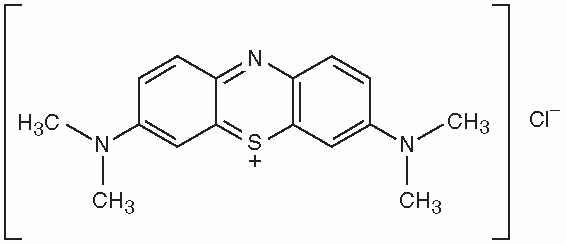There are many blue dye compounds, and each is used for a variety of purposes. Their uses include food coloring, dye for materials, antiseptics, tissue stains, chemical reaction indicators, and to treat diseased aquarium life. Blue dyes are also used in humans for both diagnostic and therapeutic purposes. These dyes include methylene blue, patent blue, isosulfan blue, and indigo carmine. While these substances are all blue in color, they are distinct compounds and have widely varying properties, uses, and adverse effects (
Table 56.1).
METHYLENE BLUE
Synonyms: Methylthionium chloride, tetramethylthionine chloride, urolene blue, swiss blue, solvent blue
Molecular formula: C16H18ClN3S
Molecular weight: 319.85
Structure:
Methylene blue has been used in many clinical situations in humans. It is used primarily as an antidote for both chronic methemoglobinemia (e.g., occurring with dapsone therapy) and acute methemoglobinemia. At low concentrations it promotes the reduction of methemoglobin (the ferric form of hemoglobin) to hemoglobin by acting as a cofactor for the enzyme NADPH-methemoglobin reductase. The recommended dose is 1 to 2 mg/kg administered intravenously (IV). The dose may be repeated after 1 hour if symptoms persist.
Methylene blue has been used as a sentinel lymph node tracer for breast cancer and may be as efficacious and have fewer side effects than other blue dyes more traditionally used for this purpose. It has also been used as a genitourinary antiseptic and for topical virus therapy. The antimicrobial effect is presumed to be secondary to its oxidative/reduction properties.
Although it is not the treatment of first choice, at high concentrations methylene blue can be used to treat cyanide toxicity by converting ferrous hemoglobin to ferric methemoglobin. Methemoglobin combines with cyanide to form cyanmethemoglobin. This serves as an alternative pathway for cyanide and prevents it from combining with cytochrome oxidase, which results in cyanide toxicity.
Possible side effects of methylene blue include hypertension; chest pain; headache; confusion; dizziness; diaphoresis; anemia; discoloration of skin, urine, and feces; nausea; vomiting; abdominal pain; and bladder irritation. The increase in blood pressure caused by methylene blue is so pronounced that it was historically used as a treatment for septic shock, before the era of modern-day vasopressors.
Only gold members can continue reading.
Log In or
Register to continue
Related

Full access? Get Clinical Tree










